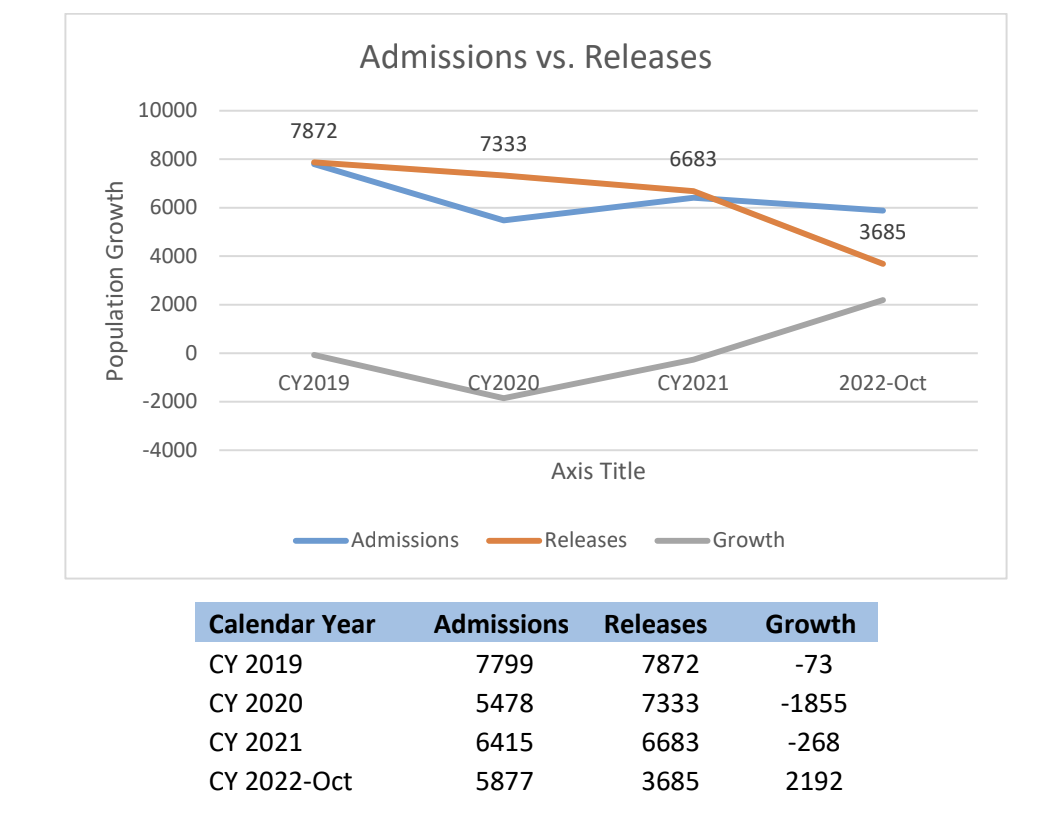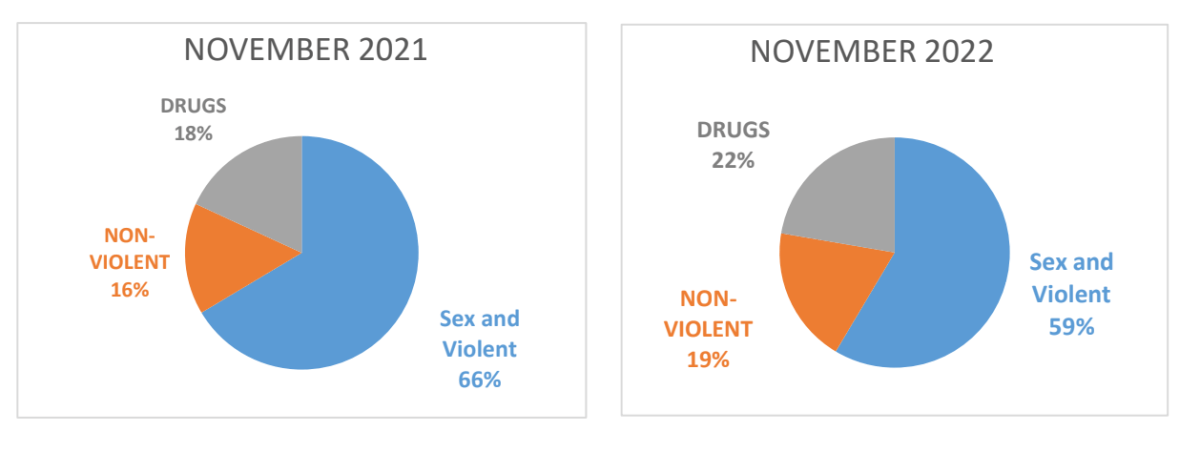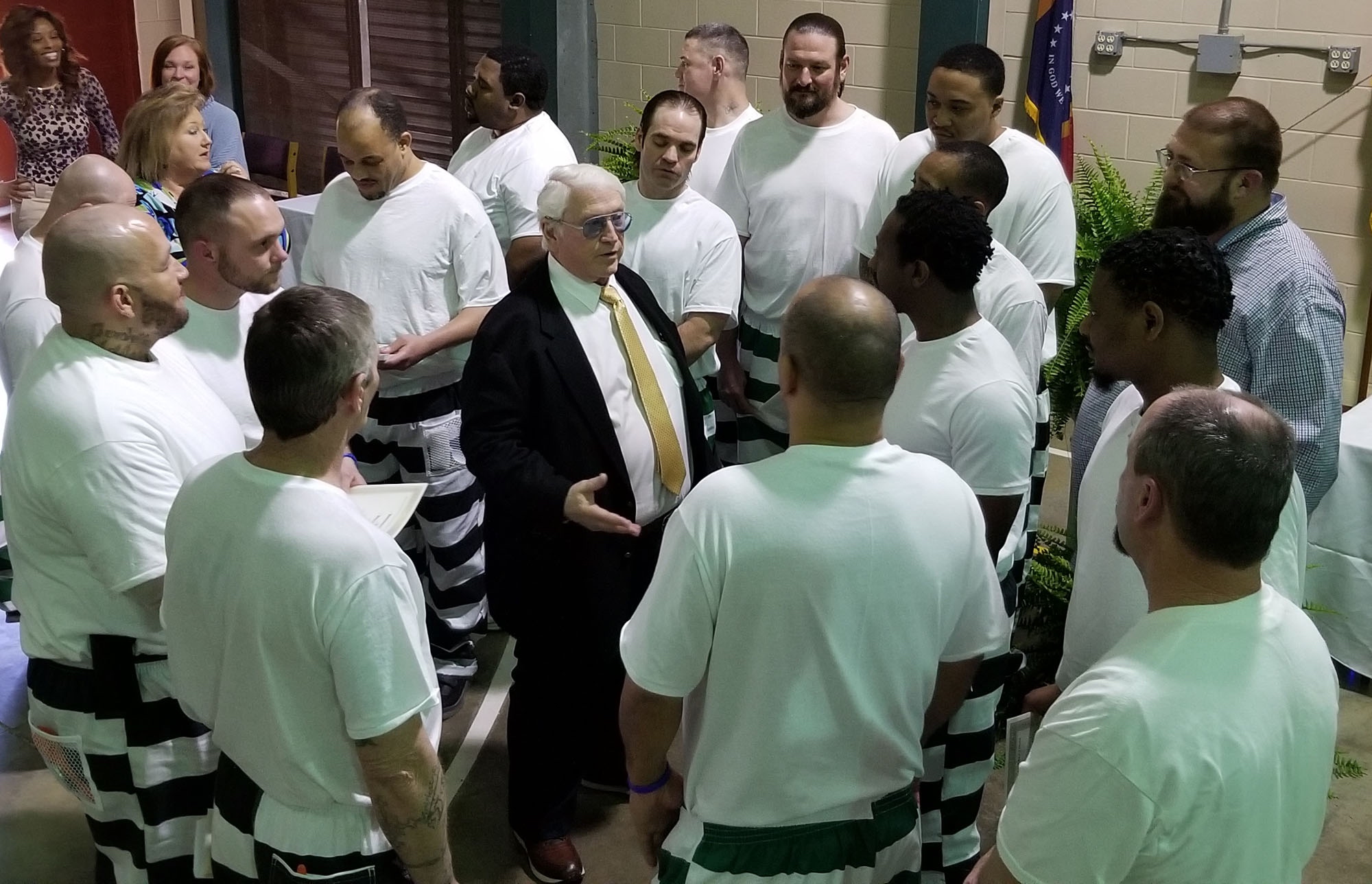Mississippi Today
Mississippi prisons may soon exceed capacity
Mississippi prisons may soon exceed capacity
Mississippi — the world’s leader in imprisoning people — will soon skyrocket past its capacity to hold them all.
In just 10 months, the state’s prison population has exploded, rising almost twice as fast as inflation. If this rate persists, the Mississippi Department of Corrections would exceed its listed capacity of 20,443 over the next several months.
Eldon Vail, an inspector of Mississippi prisons in recent years, called the alarming rate “pouring gasoline on a top of a fire that is already raging.”
Between 1993 and 2013, the state’s prison population more than quadrupled, thanks largely to mandatory minimum sentences, with the population peaking in the past decade at more than 23,000. That prompted a push for reforms that included House Bill 585, which then Republican Gov. Phil Bryant signed into law in 2014.
In the years since, reforms and an aggressive Parole Board reduced the number of inmates. By 2016, Mississippi had fallen into third place in per capita imprisonment, trailing Louisiana and Oklahoma.
Five years later, additional reform took place with the passage of the Mississippi Earned Parole Eligibility Act, which gave thousands more inmates the opportunity to go before the Parole Board. By Feb. 7, the prison population had fallen to 16,499, the lowest level in two decades.
That fall mirrored the nation, which saw the prison population decline more than 16% in all states but one between 2019 and 2021, according to the Vera Institute of Justice. (The lone holdout? Alaska, which rose 3.6%.)
But under the leadership of new Parole Board Chairman Jeffrey Belk, that trend has reversed itself.
Ten months later, Mississippi’s prison population now exceeds 19,000 in what the Corrections and Criminal Justice Oversight Task Force calls “unprecedented growth.” If this growth continues at the same rate through 2023, that population would surpass 22,500 for the first time since 2010.

If Mississippi hits that number, taxpayers would be forced to pay $111 million more a year than they were paying in 2020 before the population hike, based on the per-day cost figured by the state’s legislative watchdog, Performance Evaluation and Expenditure Review. That’s more than enough to fund the state Department of Health, the governor’s office and a dozen other state agencies.
“While other states are reducing their prison populations, Mississippi is backsliding, thanks in large part to the actions of the Parole Board,” said Cliff Johnson, director of the MacArthur Justice Center at the University of Mississippi School of Law. “It’s demoralizing. It’s infuriating. And it’s terrible corrections policy.”
The population increase has come, despite the decline in Mississippians sentenced to prison, going from 4,270 in 2018 to 3,189 over the past year, according to the task force’s report.
In an interview, Belk told MCIR that the Parole Board is “not a numbers-driven board.”
Some people want the board to “just blindly parole people and not care if they come back,” he said. “We’re not going to do that.”
For his part, Corrections Commissioner Burl Cain said he isn’t worried about MDOC surpassing capacity, because his agency is creating 660 new spaces inside Mississippi prisons. That includes a move of all female inmates from Central Mississippi Correctional Facility in Pearl to the Delta Correctional Facility in Greenwood.
To curb the rise in prison population, he’s banking on better drug rehabilitation and job training programs to reduce recidivism.
About three-fourths of those behind bars in Mississippi battle drug or alcohol problems or both. Cain said a robust rehabilitation program is now available to 2,700 different inmates.

While serving as superintendent of the Louisiana Penitentiary at Angola, he established a job training program that resulted in a three-year recidivism rate of 9.4% for those who finished the program compared with 34% for the average inmate, according to the Louisiana Commission on Law Enforcement.
He hopes to replicate that success in Mississippi, where the three-year recidivism rate is about 33% and the five-year rate is 77%, according to the 2022 World Population Review.
So far, “we have about 170 inmates in the program,” with more to come, he said.
Most of the instructors, who are inmates, earn 25 to 30 cents an hour, or about $52 a month, he said. “It gives them a little bit of independence, and it’s really good for morale.”
MDOC’s work release program plays a companion role in this. “We have 23 out of 25 inmates in jobs making $15 an hour,” he said. “They’re not going to come back.”
Senior U.S. District Judge Keith Starrett of Hattiesburg, who chairs Mississippi’s Reentry Council, praised Cain for providing job training, moral training and job certification. “Reducing recidivism saves lives, money, families and communities,” he said.
House Bill 585 sought to reduce prison overcrowding, which the Pew Foundation estimated would save Mississippi $266 million over a decade.
But the lawmakers’ promise to use those savings for corrections programming never took place, Starrett said. “The Legislature looks out for a lot of folks, but prisons and programs that reduce recidivism are way down on their list of priorities.”
The weak link is the follow-up in programming for those leaving prison, he said. “Let’s say somebody is successful in getting drug treatment, getting a GED and getting a job, but the first week on the job, they cuss at their boss and get fired.”
Now the work goes away, “and they get discouraged and start stealing or selling drugs,” he said. “You’ve got to have support, supervision and encouragement.”
The ultimate goal of both law enforcement and corrections is community safety, and the way to make the community safer is to reduce recidivism, he said. “Of those in prison, 98% are coming back into the community. What’s important is what kind of people they are when they come back. You don’t want them coming home and breaking in your mama’s house.”
Hinds County District Attorney Jody Owens II — who worked with the then-governor and lawmakers of both parties to help pass House Bill 585 — questioned the rise in inmates. “Are we safer because we are incarcerating more people?” he asked.
Former Chairman Steve Pickett said his Parole Board had a parole rate of about 60%. That is, six out of 10 inmates eligible for parole were able to go free. Belk puts his board’s rate at about 40%.
In contrast to the past board, the current one regularly sets off parole hearings for inmates for years, sometimes as much as seven years before they’re eligible again.
Belk cited the case of 80-year-old woman Evelun Smith, who has been in prison 31 years. He said she had come up for a parole hearing every six months. This time, the Parole Board set her off five years.
“She was not ‘parole-able,’” Belk said. “She didn’t know the heinousness of her crime.”
In 1991, Smith and her boyfriend, Phillip Beard, were given life sentences for their roles in stabbing to death a 28-year-old woman, Dedra McGill of Brookhaven, who had “snitched” on Beard, according to the McComb Enterprise-Journal. Smith testified that Beard had been plotting to kill McGill before she spoke to a grand jury investigating Beard’s drug dealings.
Smith is also serving a 20-year sentence for armed robbery for the couple using McGill’s car to drive them to Louisiana to dump McGill’s mutilated and burned body.
In addition to the current board granting fewer paroles, Mississippi judges are giving longer sentences, according to the task force report. The average sentence in 2018 was 7.7 years; now it’s 8.9 years. The number of those imprisoned for drug offenses has risen from 38.8% in 2018 to 47.3% over the past six months.
State Public Defender André de Gruy said he doesn’t think anyone, including the Parole Board, “knows what they are doing regarding case plans or presumptive parole. They have never followed 585 on presumptive parole.”
The state’s presumptive parole law allows MDOC to release inmates without a parole hearing if they satisfy their case plans.
“Under this program, we tell people exactly what is expected of them when they enter prison, and we reward them when they meet those expectations,” Johnson said. “Our Republican-led Legislature wisely passed the law almost a decade ago, and it has never worked like it is supposed to.”
In a 2021 report, PEER, the state lawmakers’ watchdog, concluded that the Parole Board conducted 274 unnecessary hearings for offenders who qualified for this presumptive parole.
Belk said that was PEER’s “nice way of saying they [the Parole Board and MDOC] weren’t doing it.”
He and Cain are now working to make presumptive parole a reality. That will start with creating a case plan, which will capture education levels, job skills and needs, such as alcohol or drug addictions, when an inmate enters prison, Belk said.
That plan will detail programs for the inmate to take part in, such as getting a GED, developing job skills or taking part in a recovery program, he said. If inmates complete those plans, “there’s no reason why the majority of those can’t be paroled,” he said.
If an inmate rejects chances to improve, it’s better for that inmate to wait, Belk said. “Call it tough love. Sometimes the best thing to do is not parole.”
In fact, he said, some inmates have asked the board to revoke their parole so that they could get six months of intensive drug and alcohol treatment at Walnut Grove Correctional Facility.
Ashley Lukens, president of Mississippi Dreams Prisoner Advocacy, said one major problem is inmates often can’t take classes and programs because of shortages in both correctional officers and case managers.
Since Belk took over as chairman, the Parole Board has increased the number of parole revocations from 1,949 in 2018 to an estimated 2,496 for 2022; the percentage of time served by inmates has risen from 53.5% in 2021 to 60.1% in the last quarter.
To stem this tide, de Gruy suggested the board and judges better utilize Technical Violation Centers. “A lot of people are going to prison for failure to pay fines, fees and assessments. It’s unconstitutional to send someone to prison who can’t pay.”
There needs to be reinvestment, including housing, transportation to jobs for those paroled and improvements in mental health, he said. “We need to relieve the financial burdens because 80% of people entering at arrest can’t afford a lawyer. We then add more and more financial burdens at every step of the process.”
Beyond these issues, there is the question of how many more inmates the Mississippi Department of Corrections can handle.
At the State Penitentiary at Parchman, the department has had to add bunks in order to have enough beds for inmates to sleep. Inmates in Unit 30 told MCIR they now have 104 people, but only three showers, six urinals, five toilets and five sinks.
All this is happening at the same time the department is struggling to hire and retain correctional officers, despite pay raises in recent years. MDOC officials say one of the biggest problems has been retention.
In 2014, the department had 1,591 correctional officers, according to the state Personnel Board. Today, that number is less than 1,000, even though the state is now operating two additional prisons: Walnut Grove Correctional Facility and Marshall County Correctional Facility.
Pickett, who chaired the Parole Board between 2013 and 2021, called the current correctional officer-to-inmate ratio “dangerously low.” So are the case manager numbers, he said.
“We have to accept our failure to invest in good criminal justice public policy,” he said. “We can’t keep pushing the failures back onto local police and county jails and expecting a different outcome.”
Cain said he hopes to solve this shortage through a pay raise for starting correctional officers, beginning Jan. 1. It’s a raise the Personnel Board has already approved.
Will the new pay raise succeed where the old ones failed? For years, starting officers earned $24,900 before the pay rose to $27,149. After Cain arrived in 2020, he convinced lawmakers to boost the starting salary, which is now $36,720. Despite that, MDOC continues to struggle with retaining workers. Cain hopes the newest raise to $40,248 does the trick.
Vail said in recent years, he has witnessed staffing levels so low inside Parchman and East Mississippi Correctional Facility that there wasn’t even a single officer to watch units holding prisoners of 100 or more.
“When that is the case, the vacuum of power and control is ceded to the prisoner population in the form of gangs,” said Vail, who served as corrections secretary for the state of Washington.
In an April report, Justice Department officials criticized “gross understaffing” at Parchman and “uncontrolled gang activity,” which leads to “an environment rife with weapons, drugs, gang violence and extortion. … MDOC officials have long known about these unsafe prison conditions, but have continually failed to correct the conditions.”
In recent months, Parchman has seen a new wave of violence.
On Sept. 26, inmate Richard Weems, who was serving 25 years for armed robbery and 25 years for kidnapping out of Madison County, was killed by blunt force trauma to his head.
Two weeks later, inmate Markeith Williams, who was serving a 25-year sentence for armed robbery out of Grenada County, was stabbed to death in Parchman’s Unit 29, which has a long history of violence, including the killings of three inmates in a 2019-2020 riot.
Despite having the highest incarceration rate in the nation, Mississippi spends less per inmate than any other state.
“Lack of adequate funding is the primary reason for the extraordinary levels of violence and death in the Mississippi Department of Corrections,” Vail said.
Whatever momentum there might have been to parole more people from prison may have been undone by the case of Frederick Bell, whom the Parole Board voted to release under supervision after he served 31 years behind bars for the 1991 killing of a 21-year-old clerk during a store robbery. He also pleaded guilty to killing a 20-year-old man in Memphis.
Bell committed the crimes when he was 19, and now he serves as a mentor, teacher and pastor behind bars.
In August, the Parole Board concluded that he had been rehabilitated and voted to free him, but when criticism followed, the board reversed its decision — just hours before he was slated to walk out the doors of Parchman prison.
Brandon Jones, director of political campaigns for the Southern Poverty Law Center, criticized Mississippi’s “terrible thicket of sentencing laws,” which include “one of the most unforgiving habitual offender arrangements in the world.”
This means thousands of Mississippians held behind bars have “no path to parole at all,” he said. “There needs to be more reasonable paths to parole and a Parole Board that sees the value in second chances.”
Email Jerry.Mitchell@MississippiCIR.org. You can follow him on Facebook, Twitter or Instagram.
This story was produced by the Mississippi Center for Investigative Reporting, a nonprofit news organization that is exposing wrongdoing, educating and empowering Mississippians, and raising up the next generation of investigative reporters. Sign up for our newsletter.
This article first appeared on Mississippi Today and is republished here under a Creative Commons license.
Mississippi Today
Mississippi prepares for another execution
The Mississippi Supreme Court has set the execution of a man who kidnapped and murdered a 20-year-old community college student in north Mississippi 30 years ago.
Charles Ray Crawford, 59, is set to be executed Oct. 15 at the Mississippi State Penitentiary at Parchman, after multiple requests by the attorney general’s office.
Eight justices joined the majority opinion to set the execution, concluding that Crawford has exhausted all state and federal legal remedies. Mississippi Supreme Court Justice T. Kenneth Griffis Jr. wrote the Friday opinion. Justice David Sullivan did not participate.
However, Kristy Noble with the Mississippi Office of Capital Post-Conviction Counsel released a statement saying it will file another appeal with the U.S. Supreme Court.
“”Mr. Crawford’s inexperienced trial counsel conceded his guilt to the jury — against Mr.
Crawford’s timely and repeated objections,” Noble said in the statement. “Mr. Crawford told his counsel to pursue a not guilty verdict. Counsel did just the opposite, which is precisely what the U.S. Supreme Court says counsel cannot do,” Noble said in the statement.
“A trial like Mr. Crawford’s – one where counsel concedes guilt over his client’s express wishes – is essentially no trial at all.”
Last fall, Crawford’s attorneys asked the court not to set an execution date because he hadn’t exhausted appeal efforts in federal court to challenge a rape conviction that is not tied to his death sentence. In June, the U.S. Supreme Court declined to take up Crawford’s case.
A similar delay occurred a decade ago, when the AG’s office asked the court to reset Crawford’s execution date, but that was denied because efforts to appeal his unrelated rape conviction were still pending.
After each unsuccessful filing, the attorney general’s office asked the Mississippi Supreme Court to set Crawford’s execution date.
On Friday, the court also denied Crawford’s third petition for post-conviction relief and a request for oral argument. It accepted the state’s motion to dismiss the petition. Seven justices concurred and Justice Leslie King concurred in result only. Again, Justice Sullivan did not participate.
Crawford was convicted and sentenced to death in Lafayette County for the 1993 rape and murder of North Mississippi Community College student Kristy Ray.
Days before he was set to go to trial on separate aggravated assault and rape charges, he kidnapped Ray from her parents’ Tippah County home, leaving ransom notes. Crawford took Ray to an abandoned barn where he stabbed her, and his DNA was found on her, indicating he sexually assaulted her, according to court records.
Crawford told police he had blackouts and only remembered parts of the crime, but not killing Ray. Later he admitted “he must of killed her” and led police to Ray’s body, according to court records.
At his 1994 trial he presented an insanity defense, including that he suffered from psychogenic amnesia – periods of time lapse without memory. Medical experts who provided rebuttal testimony said Crawford didn’t have psychogenic amnesia and didn’t show evidence of bipolar illness.
The last person executed in Mississippi was Richard Jordan in June, previously the state’s oldest and longest serving person on death row.
There are 36 people on death row, according to records from the Mississippi Department of Corrections.
Update 9/15/25: This story has been updated to include a response from the Mississippi Office of Capital Post-Conviction Counsel
This article first appeared on Mississippi Today and is republished here under a Creative Commons Attribution-NoDerivatives 4.0 International License.
The post Mississippi prepares for another execution appeared first on mississippitoday.org
Note: The following A.I. based commentary is not part of the original article, reproduced above, but is offered in the hopes that it will promote greater media literacy and critical thinking, by making any potential bias more visible to the reader –Staff Editor.
Political Bias Rating: Centrist
The article presents a factual and balanced account of the legal proceedings surrounding a scheduled execution in Mississippi. It includes perspectives from both the state’s attorney general’s office and the defense counsel, without using emotionally charged language or advocating for a particular political stance. The focus on legal details and court decisions reflects a neutral, informative approach typical of centrist reporting.
Mississippi Today
Presidents are taking longer to declare major natural disasters. For some, the wait is agonizing
TYLERTOWN — As an ominous storm approached Buddy Anthony’s one-story brick home, he took shelter in his new Ford F-250 pickup parked under a nearby carport.
Seconds later, a tornado tore apart Anthony’s home and damaged the truck while lifting it partly in the air. Anthony emerged unhurt. But he had to replace his vehicle with a used truck that became his home while waiting for President Donald Trump to issue a major disaster declaration so that federal money would be freed for individuals reeling from loss. That took weeks.
“You wake up in the truck and look out the windshield and see nothing. That’s hard. That’s hard to swallow,” Anthony said.
Disaster survivors are having to wait longer to get aid from the federal government, according to a new Associated Press analysis of decades of data. On average, it took less than two weeks for a governor’s request for a presidential disaster declaration to be granted in the 1990s and early 2000s. That rose to about three weeks during the past decade under presidents from both major parties. It’s taking more than a month, on average, during Trump’s current term, the AP found.
The delays mean individuals must wait to receive federal aid for daily living expenses, temporary lodging and home repairs. Delays in disaster declarations also can hamper recovery efforts by local officials uncertain whether they will receive federal reimbursement for cleaning up debris and rebuilding infrastructure. The AP collaborated with Mississippi Today and Mississippi Free Press on the effects of these delays for this report.
“The message that I get in the delay, particularly for the individual assistance, is that the federal government has turned its back on its own people,” said Bob Griffin, dean of the College of Emergency Preparedness, Homeland Security and Cybersecurity at the University at Albany in New York. “It’s a fundamental shift in the position of this country.”
The wait for disaster aid has grown as Trump remakes government
The Federal Emergency Management Agency often consults immediately with communities to coordinate their initial disaster response. But direct payments to individuals, nonprofits and local governments must wait for a major disaster declaration from the president, who first must receive a request from a state, territory or tribe. Major disaster declarations are intended only for the most damaging events that are beyond the resources of states and local governments.
Trump has approved more than two dozen major disaster declarations since taking office in January, with an average wait of almost 34 days after a request. That ranged from a one-day turnaround after July’s deadly flash flooding in Texas to a 67-day wait after a request for aid because of a Michigan ice storm. The average wait is up from a 24-day delay during his first term and is nearly four times as long as the average for former Republican President George H.W. Bush, whose term from 1989-1993 coincided with the implementation of a new federal law setting parameters for disaster determinations.
The delays have grown over time, regardless of the party in power. Former Democratic President Joe Biden, in his last year in office, averaged 26 days to declare major disasters — longer than any year under former Democratic President Barack Obama.

FEMA did not respond to the AP’s questions about what factors are contributing to the trend.
Others familiar with FEMA noted that its process for assessing and documenting natural disasters has become more complex over time. Disasters have also become more frequent and intense because of climate change, which is mostly caused by the burning of fuels such as gas, coal and oil.
The wait for disaster declarations has spiked as Trump’s administration undertakes an ambitious makeover of the federal government that has shed thousands of workers and reexamined the role of FEMA. A recently published letter from current and former FEMA employees warned the cuts could become debilitating if faced with a large-enough disaster. The letter also lamented that the Trump administration has stopped maintaining or removed long-term planning tools focused on extreme weather and disasters.
Shortly after taking office, Trump floated the idea of “getting rid” of FEMA, asserting: “It’s very bureaucratic, and it’s very slow.”
FEMA’s acting chief suggested more recently that states should shoulder more responsibility for disaster recovery, though FEMA thus far has continued to cover three-fourths of the costs of public assistance to local governments, as required under federal law. FEMA pays the full cost of its individual assistance.
Former FEMA Administrator Pete Gaynor, who served during Trump’s first term, said the delay in issuing major disaster declarations likely is related to a renewed focus on making sure the federal government isn’t paying for things state and local governments could handle.
“I think they’re probably giving those requests more scrutiny,” Gaynor said. “And I think it’s probably the right thing to do, because I think the (disaster) declaration process has become the ‘easy button’ for states.”
The Associated Press on Monday received a statement from White House spokeswoman Abigail Jackson in response to a question about why it is taking longer to issue major natural disaster declarations:
“President Trump provides a more thorough review of disaster declaration requests than any Administration has before him. Gone are the days of rubber stamping FEMA recommendations – that’s not a bug, that’s a feature. Under prior Administrations, FEMA’s outsized role created a bloated bureaucracy that disincentivized state investment in their own resilience. President Trump is committed to right-sizing the Federal government while empowering state and local governments by enabling them to better understand, plan for, and ultimately address the needs of their citizens. The Trump Administration has expeditiously provided assistance to disasters while ensuring taxpayer dollars are spent wisely to supplement state actions, not replace them.”

In Mississippi, frustration festered during wait for aid
The tornado that struck Anthony’s home in rural Tylertown on March 15 packed winds up to 140 mph. It was part of a powerful system that wrecked homes, businesses and lives across multiple states.
Mississippi’s governor requested a federal disaster declaration on April 1. Trump granted that request 50 days later, on May 21, while approving aid for both individuals and public entities.
On that same day, Trump also approved eight other major disaster declarations for storms, floods or fires in seven other states. In most cases, more than a month had passed since the request and about two months since the date of those disasters.
If a presidential declaration and federal money had come sooner, Anthony said he wouldn’t have needed to spend weeks sleeping in a truck before he could afford to rent the trailer where he is now living. His house was uninsured, Anthony said, and FEMA eventually gave him $30,000.
In nearby Jayess in Lawrence County, Dana Grimes had insurance but not enough to cover the full value of her damaged home. After the eventual federal declaration, Grimes said FEMA provided about $750 for emergency expenses, but she is now waiting for the agency to determine whether she can receive more.

“We couldn’t figure out why the president took so long to help people in this country,” Grimes said. “I just want to tie up strings and move on. But FEMA — I’m still fooling with FEMA.”
Jonathan Young said he gave up on applying for FEMA aid after the Tylertown tornado killed his 7-year-old son and destroyed their home. The process seemed too difficult, and federal officials wanted paperwork he didn’t have, Young said. He made ends meet by working for those cleaning up from the storm.
“It’s a therapy for me,” Young said, “to pick up the debris that took my son away from me.”
Historically, presidential disaster declarations containing individual assistance have been approved more quickly than those providing assistance only to public entities, according to the AP’s analysis. That remains the case under Trump, though declarations for both types are taking longer.
About half the major disaster declarations approved by Trump this year have included individual assistance.
Some people whose homes are damaged turn to shelters hosted by churches or local nonprofit organizations in the initial chaotic days after a disaster. Others stay with friends or family or go to a hotel, if they can afford it.
But some insist on staying in damaged homes, even if they are unsafe, said Chris Smith, who administered FEMA’s individual assistance division under three presidents from 2015-2022. If homes aren’t repaired properly, mold can grow, compounding the recovery challenges.

That’s why it’s critical for FEMA’s individual assistance to get approved quickly — ideally, within two weeks of a disaster, said Smith, who’s now a disaster consultant for governments and companies.
“You want to keep the people where they are living. You want to ensure those communities are going to continue to be viable and recover,” Smith said. “And the earlier that individual assistance can be delivered … the earlier recovery can start.”
In the periods waiting for declarations, the pressure falls on local officials and volunteers to care for victims and distribute supplies.
In Walthall County, where Tylertown is, insurance agent Les Lampton remembered watching the weather news as the first tornado missed his house by just an eighth of a mile. Lampton, who moonlights as a volunteer firefighter, navigated the collapsed trees in his yard and jumped into action. About 45 minutes later, the second tornado hit just a mile away.
“It was just chaos from there on out,” Lampton said.
Walthall County, with a population of about 14,000, hasn’t had a working tornado siren in about 30 years, Lampton said. He added there isn’t a public safe room in the area, although a lot of residents have ones in their home.
Rural areas with limited resources are hit hard by delays in receiving funds through FEMA’s public assistance program, which, unlike individual assistance, only reimburses local entities after their bills are paid. Long waits can stoke uncertainty and lead cost-conscious local officials to pause or scale-back their recovery efforts.

In Walthall County, officials initially spent about $700,000 cleaning up debris, then suspended the cleanup for more than a month because they couldn’t afford to spend more without assurance they would receive federal reimbursement, said county emergency manager Royce McKee. Meanwhile, rubble from splintered trees and shattered homes remained piled along the roadside, creating unsafe obstacles for motorists and habitat for snakes and rodents.
When it received the federal declaration, Walthall County took out a multimillion-dollar loan to pay contractors to resume the cleanup.
“We’re going to pay interest and pay that money back until FEMA pays us,” said Byran Martin, an elected county supervisor. “We’re hopeful that we’ll get some money by the first of the year, but people are telling us that it could be [longer].”
Lampton, who took after his father when he joined the volunteer firefighters 40 years ago, lauded the support of outside groups such as Cajun Navy, Eight Days of Hope, Samaritan’s Purse and others. That’s not to mention the neighbors who brought their own skid steers and power saws to help clear trees and other debris, he added.
“That’s the only thing that got us through this storm, neighbors helping neighbors,” Lampton said. “If we waited on the government, we were going to be in bad shape.”
Lieb reported from Jefferson City, Missouri, and Wildeman from Hartford, Connecticut.
Update 98/25: This story has been updated to include a White House statement released after publication.
This article first appeared on Mississippi Today and is republished here under a Creative Commons Attribution-NoDerivatives 4.0 International License.
The post Presidents are taking longer to declare major natural disasters. For some, the wait is agonizing appeared first on mississippitoday.org
Note: The following A.I. based commentary is not part of the original article, reproduced above, but is offered in the hopes that it will promote greater media literacy and critical thinking, by making any potential bias more visible to the reader –Staff Editor.
Political Bias Rating: Center-Left
This article presents a critical view of the Trump administration’s handling of disaster declarations, highlighting delays and their negative impacts on affected individuals and communities. It emphasizes concerns about government downsizing and reduced federal support, themes often associated with center-left perspectives that favor robust government intervention and social safety nets. However, it also includes statements from Trump administration officials defending their approach, providing some balance. Overall, the tone and framing lean slightly left of center without being overtly partisan.
Mississippi Today
Northeast Mississippi speaker and worm farmer played key role in Coast recovery after Hurricane Katrina
The 20th anniversary of Hurricane Katrina slamming the Mississippi Gulf Coast has come and gone, rightfully garnering considerable media attention.
But still undercovered in the 20th anniversary saga of the storm that made landfall on Aug. 29, 2005, and caused unprecedented destruction is the role that a worm farmer from northeast Mississippi played in helping to revitalize the Coast.
House Speaker Billy McCoy, who died in 2019, was a worm farmer from the Prentiss, not Alcorn County, side of Rienzi — about as far away from the Gulf Coast as one could be in Mississippi.
McCoy grew other crops, but a staple of his operations was worm farming.
Early after the storm, the House speaker made a point of touring the Coast and visiting as many of the House members who lived on the Coast as he could to check on them.
But it was his action in the forum he loved the most — the Mississippi House — that is credited with being key to the Coast’s recovery.
Gov. Haley Barbour had called a special session about a month after the storm to take up multiple issues related to Katrina and the Gulf Coast’s survival and revitalization. The issue that received the most attention was Barbour’s proposal to remove the requirement that the casinos on the Coast be floating in the Mississippi Sound.
Katrina wreaked havoc on the floating casinos, and many operators said they would not rebuild if their casinos had to be in the Gulf waters. That was a crucial issue since the casinos were a major economic engine on the Coast, employing an estimated 30,000 in direct and indirect jobs.
It is difficult to fathom now the controversy surrounding Barbour’s proposal to allow the casinos to locate on land next to the water. Mississippi’s casino industry that was birthed with the early 1990s legislation was still new and controversial.
Various religious groups and others had continued to fight and oppose the casino industry and had made opposition to the expansion of gambling a priority.
Opposition to casinos and expansion of casinos was believed to be especially strong in rural areas, like those found in McCoy’s beloved northeast Mississippi. It was many of those rural areas that were the homes to rural white Democrats — now all but extinct in the Legislature but at the time still a force in the House.
So, voting in favor of casino expansion had the potential of being costly for what was McCoy’s base of power: the rural white Democrats.
Couple that with the fact that the Democratic-controlled House had been at odds with the Republican Barbour on multiple issues ranging from education funding to health care since Barbour was inaugurated in January 2004.
Barbour set records for the number of special sessions called by the governor. Those special sessions often were called to try to force the Democratic-controlled House to pass legislation it killed during the regular session.
The September 2005 special session was Barbour’s fifth of the year. For context, current Gov. Tate Reeves has called four in his nearly six years as governor.
There was little reason to expect McCoy to do Barbour’s bidding and lead the effort in the Legislature to pass his most controversial proposal: expanding casino gambling.
But when Barbour ally Lt. Gov. Amy Tuck, who presided over the Senate, refused to take up the controversial bill, Barbour was forced to turn to McCoy.
The former governor wrote about the circumstances in an essay he penned on the 20th anniversary of Hurricane Katrina for Mississippi Today Ideas.
“The Senate leadership, all Republicans, did not want to go first in passing the onshore casino law,” Barbour wrote. “So, I had to ask Speaker McCoy to allow it to come to the House floor and pass. He realized he should put the Coast and the state’s interests first. He did so, and the bill passed 61-53, with McCoy voting no.
“I will always admire Speaker McCoy, often my nemesis, for his integrity in putting the state first.”
Incidentally, former Rep. Bill Miles of Fulton, also in northeast Mississippi, was tasked by McCoy with counting, not whipping votes, to see if there was enough support in the House to pass the proposal. Not soon before the key vote, Miles said years later, he went to McCoy and told him there were more than enough votes to pass the legislation so he was voting no and broached the idea of the speaker also voting no.
It is likely that McCoy would have voted for the bill if his vote was needed.
Despite his no vote, the Biloxi Sun Herald newspaper ran a large photo of McCoy and hailed the Rienzi worm farmer as a hero for the Mississippi Gulf Coast.
This article first appeared on Mississippi Today and is republished here under a Creative Commons Attribution-NoDerivatives 4.0 International License.
The post Northeast Mississippi speaker and worm farmer played key role in Coast recovery after Hurricane Katrina appeared first on mississippitoday.org
Note: The following A.I. based commentary is not part of the original article, reproduced above, but is offered in the hopes that it will promote greater media literacy and critical thinking, by making any potential bias more visible to the reader –Staff Editor.
Political Bias Rating: Centrist
The article presents a factual and balanced account of the political dynamics surrounding Hurricane Katrina recovery efforts in Mississippi, focusing on bipartisan cooperation between Democratic and Republican leaders. It highlights the complexities of legislative decisions without overtly favoring one party or ideology, reflecting a neutral and informative tone typical of centrist reporting.
-
News from the South - Alabama News Feed7 days ago
Alabama lawmaker revives bill to allow chaplains in public schools
-
News from the South - Arkansas News Feed7 days ago
Arkansas’s morning headlines | Sept. 9, 2025
-
News from the South - Missouri News Feed7 days ago
Pulaski County town faces scrutiny after fatal overdose
-
News from the South - Texas News Feed7 days ago
‘Resilience and hope’ in Galveston: 125 years after greatest storm in US history | Texas
-
News from the South - Kentucky News Feed5 days ago
Lexington man accused of carjacking, firing gun during police chase faces federal firearm charge
-
News from the South - Arkansas News Feed6 days ago
Group in lawsuit say Franklin county prison land was bought before it was inspected
-
The Center Square6 days ago
California mother says daughter killed herself after being transitioned by school | California
-
Mississippi News Video6 days ago
Carly Gregg convicted of all charges















































